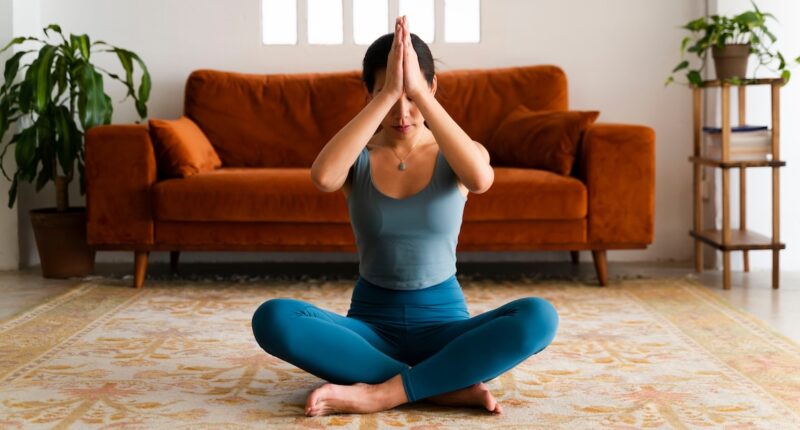But what exactly sets them apart? We asked our experts to lay down the differences in their origins, techniques, and potential health benefits.
The differences and similarities between mindfulness vs. meditation
Mindfulness and meditation both aim to decrease stress and develop awareness, peace, and clear thinking, according to Millie Huckabee, LCPC, a licensed professional counselor and the founder and CEO of Sage Therapy. Despite these common goals, they differ significantly in their approaches and applications.
Huckabee explains that mindfulness involves concentrating fully on the present moment while observing thoughts, emotions, and sensations without passing judgment on them. This practice centers on being fully present in the now and is easily accessible. Individuals can practice mindfulness during various daily activities such as eating, working, walking, or engaging in any other task.
On the other hand, meditation is a more structured and dedicated practice that requires setting aside specific time to focus the mind, often utilizing techniques that promote mindfulness, relaxation, or other positive mental states. This could involve methods like visualization, deep breathing, body scan meditations, or a variety of other meditative exercises.
Despite their differences, they have one important thing in common: they take practice. “Remember when practicing mindfulness and/or meditation that it’s a muscle you build up,” says Huckabee. “It’s okay if you can’t sit down and be perfectly ‘in the moment’ the first time you try.” Like any other skill, these grounding practices take some time to master—so be patient with yourself as you get started on this journey.
What is mindfulness?
Mindfulness is the practice of being fully present and aware in each moment. This means observing what you’re doing, thinking, and feeling right now—without judgment.
“Mindfulness has its roots in ancient Buddhist practices, where it was a core part of the path to enlightenment,” says Huckabee. “It emphasized staying fully aware of the present moment; observing thoughts and emotions without attachment,” she adds. In more recent history, though, mindfulness has been secularized and integrated into Western psychology.
An April 2023 study in BJPsych Bulletin noted the modern mindfulness movement can be largely attributed to Jon Kabat-Zinn, who developed mindfulness-based stress reduction (MBSR) therapy in the late 1970s to help people manage pain and stress. Since then, it’s become a regular technique to manage the symptoms of various mental health conditions like anxiety and depression, and in certain situations, physical health concerns such as chronic pain.
How to practice mindfulness
Practicing mindfulness is all about bringing your full attention to whatever you’re doing, says Huckabee. Her advice? “Start by choosing an everyday activity, like eating or walking, and fully focus on the experience. For example, noticing tastes, smells, and sensations [while eating], or the feeling of your feet on the ground [while walking],” she says.
“You can also practice mindfulness by setting aside a few minutes to focus on your breathing, gently bringing your mind back whenever it wanders, without judgment.” Some other ways you can incorporate mindfulness in your everyday life include the following, per the National Institutes of Health (NIH):
- Slowly scan your body from your head to your toes, noticing the sensations you’re feeling in each body part.
- Take a few moments to notice the rhythm and sensation of your breath.
- Focus on the tastes, textures, and smells of the food you eat.
What is meditation?
If mindfulness is a technique you can use at any time, in any situation, think of meditation as its more formal cousin that helps train your mind, according to Huckabee.
“Meditation is a structured practice where you intentionally focus your mind to achieve a state of calm, clarity, and inner peace,” says Huckabee. “Think of it as a workout for your mind, helping you build focus, reduce stress, and cultivate a sense of well-being.” Like mindfulness, meditation also originates from ancient spiritual traditions in Hinduism, Buddhism, and Daoism.
Because of its proven health benefits, many healthcare providers have begun recommending meditation to patients to help them decrease stress and anxiety levels, slow their heart rate, and energize their bodies, per a July 2015 study in An International Quarterly Journal of Research in Ayurveda2.
How to practice meditation
There are many types of meditation. But generally, meditation involves concentrating on something in particular (think: your breath, a mantra, or a sensation).
Before you start, Huckabee recommends finding a quiet, comfortable place to sit or lie down with your eyes closed. Then turn your attention to the focus of the meditation. “When your mind wanders (and it will!), just notice it, and calmly guide your attention back, repeating this process for a few minutes to start, gradually increasing the time as you get more comfortable,” says Huckabee.
And just because it’s a more formal practice doesn’t mean it has to take much time. Micro-meditations are a great place to start, with some as short as one minute. Here are a few techniques to get you started:
- Alternate nostril breathing: Pinch your nose shut with your thumb and pointer finger. Press your right nostril shut and inhale through your left, then press your left nostril shut and exhale through your right. Repeat this pattern for as long as you like.
- Resonant breathing: Breathe in a rhythm where you exhale for longer than you inhale (for example, inhale for four seconds, then exhale for six).
- Repeating a mantra: Pick your favorite affirmation (or create your own!). Repeat it to yourself in your head or out loud as you breathe deeply.
Want more ideas? Try a meditation app like Calm (7-day free trial; $69.99 per year) or Headspace ($12.99 per month; $34.99 per year) to access guided meditations.
Health benefits of mindfulness and meditation
Both mindfulness and meditation share a wide array of health benefits. These include:
1. Reducing stress, depression, and anxiety
Mindfulness helps you ground yourself in the present, taking the focus off of past or future events that could cause distress, per the NIH.
Similarly, meditation has been linked to changes in brain structure and function, both of which can decrease symptoms of anxiety and depression, according to a July 2020 study in General Psychiatry.
2. Lowering blood pressure
According to a March 2021 review in the International Journal of Environmental Research and Public Health, mindfulness-based meditation stress-reduction programs are linked to decreased blood pressure, which can support overall heart health and lower your risk of chronic conditions like heart disease and stroke.
3. Enhancing sleep
If you’ve considered trying meditation for sleep, it’s not a bad idea. Meditation has been linked to the ability to fall asleep faster and enhanced sleep quality, according to UC Davis Health.
Mindfulness has also been associated with improved sleep. A May 2020 study in Sleep Health found that people who trained in mindfulness-based stress-reduction techniques also experienced better sleep quality.
4. Boosting focus and memory
Practicing mindfulness and meditation regularly can improve your ability to focus on your internal thoughts and sensations. And this applies to other areas of life, as well. According to Harvard Health, mindfulness can increase focus and concentration in your everyday life, while also helping you retain important information.
5. Minimizing chronic pain
Mindfulness and meditation practices have been linked to reduced short- and long-term chronic pain, per a July 2022 review in Neurosurgery Clinics of North America6. If you live with a condition that cause frequent bouts of discomfort, adding mindfulness or meditation to your treatment regimen may be worth the try.
6. Bettering emotional regulation
A study in Current Opinion in Psychology linked mindfulness to increased emotional recovery, more positive emotional responses, and less avoidant behavior (though the researchers note that more studies are needed to further establish this connection).
However, another study published in the International Journal of Environmental Research and Public Health found that mindfulness meditation techniques are linked to better emotional balance, awareness, and acceptance, along with less emotional exhaustion.
7. Increasing self-awareness
Spending time focusing on your emotions and physical sensations through mindfulness and meditation can deepen your physical and mental awareness, which can contribute to an overall stronger sense of self, according to Huckabee.
8. Improving relationships
Practicing mindfulness and meditation can help you become a more present person overall. Spending more time in the now and being aware of what’s going in right in front of you is a good way to deepen empathy and strengthen your relationships, says Huckabee.
The bottom line
While meditation and mindfulness have their differences, one thing is clear: either (or both!) of these practices boasts several potential health benefits. If you’re looking to add a low-lift, high-reward practice to your self-care routine, look no further. While we know that any new habit takes a second (okay, maybe more than a second) to master, starting now can help you reach a variety of benefits down the line.





